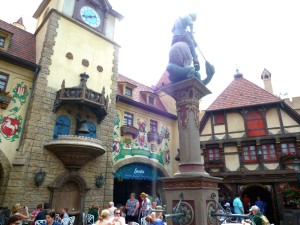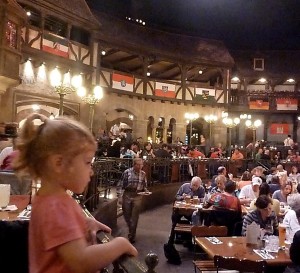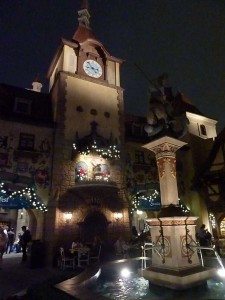Drinks of Disney World: Vol 3 – Germany
There are few places that I enjoy more than Germany, with its immense amounts of history, culture, and beauty everywhere you look. The history and culture carry over into the drinks available in this remarkable nation. Luckily for visitors at Walt Disney World, these things are adequately replicated in the Epcot pavilion.
As you have probably assumed if you ever walked by the Germany pavilion on a Saturday night, there are quite a few alcoholic beverages served. While certain types hover around the pavilion in order to consume way too many drinks, I am hoping to inspire you to appreciate the adult beverage in your hand by using the history and culture behind those drinks (and, of course, my sparkling wit).
Jägermeister
I am starting with this digestif from the north of Germany for three reasons: 1) It is probably the most well known brand name served in the Germany pavilion, 2) It has a relatively boring story, and 3) I do not like it Sam-I-Am.
The name Jägermeister is translated as “hunt master” and was commonly used in Germany in the mid-1930s, which is when the liqueur was created. It is made from a secret combination of 56 herbs, fruits, roots, and spices that are mixed, aged, and filtered. You will find plenty of Jäger flowing in Germany (both country and pavilion), but in the former nation of Bavaria you are more likely to find…
Schnapps
Immensely popular in southern Germany (which I will call Bavaria…because that is what it is called), schnapps is a clear brandy with a light fruit flavor. Unlike some American liquors, German schnapps does not contain added sugar or fruit extracts. German Schnapps is also a liquor not a liqueur (don’t look so confused).
A liqueur is made by taking a high-proof spirit and steeping fruit, herbs, or spices in said spirit until the liqueur takes on those flavors (see Jägermeister). A liquor is the distilled spirit itself, which can be made using fruit, herbs, or spices in the distilling process (see Schnapps).
While it has a relatively low alcohol content of 40%, the taste of true German schnapps is akin to vodka with hint of fruit (i.e,. it is a little harsh). It will definitely warm your heart (and throat…and stomach…and liver) during a cold Bavarian winter.
The gift of fermented grapes is not one commonly associated with Germany, but you may have noticed the Weinkeller as part of the pavilion. If you are a bit rusty on your German, weinkeller translates as Kelly’s Wieners…or maybe wine cellar…hmm, my German may be a bit rusty. Regardless, what is found in this little room is a fine selection of wine from Deutschland (which I think is ‘dairy farm’ in English).
The vast majority of good German wines are whites, and many of those are Rieslings (REES-ling). Without going into full Wine 101, there are two basic ways to classify a wine: by grape variety or by region. If a region is a strong winemaker, that is usually the preference as it signifies some specific traits (well known wine regions are Chianti, Chablis, and Champagne). Otherwise, a wine will be classified by the type of grape (such as Merlot or Chardonnay). Riesling is a type of grape that makes a crisp, slightly fruity white wine.
Contrary to what many think, wine making in Germany is extremely old, dating to sometime around the year 200. Riesling making has been documented as far back as 1435 in the west of Germany, where many wines are still produced today.
Although Riesling is the most common, there are two fairly interesting types of wines you may also come across: Sekt and Spatlese. Sekt is simply sparkling white wine made from common German grape varietals (yes, usually Riesling). Production began in 1826 when a German who had previously worked in Champagne moved back home. It is bubbly and light like Champagne, but less dry and with a little more fruit flavor to it.
Spatlese is a stranger wine made like so many great things…by accident. The name literally means ‘late harvest’ and the grapes are harvested, uh, late. Because of the extra age of the grapes, they are overripe, making the wine more intensely flavored and complex.
The wine was discovered in 1775 when a courier placing a large wine order was delayed by two weeks, thus taking the grapes past their proper date. The grapes were harvested and wine produced with little hope of ever making anything good. The results were surprising, and now Spatlese is produced on purpose.
Beer
Now we come to it, the drink Germany is known for. As I have probably proven too many times, I am a man who enjoys a good beer, and beer from Germany is almost all very, very good. There are far too many different styles and types to list, so I will focus on two main styles that you can find in Epcot: pilsner and Oktoberfest.
Before I get to the actual types, there is little point in mentioning German beer without speaking of the Reinheitsgabot (rine-HITE-ska-boot…one of my favorite German words). More commonly known as the “German Beer Purity Law,” it was the first law passed in the world that governed food products. It was originally put forth in Bavaria (the semi-disputed king of beer regions) in 1487, and it said that only three ingredients may be used in beer making; water, barley, and hops. Over time the law was adjusted to include yeast (they didn’t know such micro-organisms existed in 1487). Notice that fruit, chocolate, coffee, milk, and other such craft brewery favorites need not apply (sorry, I’m a snob).

Now the beer: Pilsner is a light-colored lager-style beer that traditionally has a strong, sharp taste. Technically American light beers such as Budweiser and Miller are pilsners, but if I ever hear you comparing them to a real pilsner, I swear to you I will…(okay, deep breaths. Sorry about that!). Anyway, pilsners in Germany date back to 1842, although very similar beer had been brewed in abbeys for centuries prior.
Oktoberfest is quite possibly the beer type that has the most fun story. The date was October 12, 1810, and Prince Ludwig was to be married to the (presumably) lovely Princess Therese of Bavaria. Being Germans, the citizens of Munich were invited to party in the fields outside of the city gate prior to the wedding. Also being Germans, beer was involved. To this day, the celebration continues for the two weeks prior to the first Sunday in October (it was moved up a touch), and, yes, that means that most of Oktoberfest is, in fact, in September.
The beer part of the story reads thusly: Hofbrau brewery in Munich brewed a special celebration beer for that special day in 1810 (lots of special-ness going on). In the following years more breweries began brewing special Oktoberfest versions (which are Martzen style beers, but that is a lesson for another time). To regulate these brews (because Germans love them some regulation), some rules were established: 1) They must adhere to the Reinheitsgabot, 2) must be right around 6% alcohol by volume, and 3) must be brewed by a Munich brewery within the city limits.
What that leaves is exactly six true Oktoberfests: Hofbrau, Spaten, Lowenbrau, Augustiner, Paulaner, and Hacker-Pschorr. I hate to be a bummer, but the Altenmünster Oktoberfest sold in Epcot is brewed in Kempton, a small town in southwest Bavaria. While it is a good beer, it is not, nor will it ever be, a real Oktoberfest (instead settling for “Oktoberfest-style”). What is good news is that, if you eat at Biergarten in Epcot, you can get beer such as Altenmünster in gigantic one liter mugs, just like the Germans like them.
I think that is plenty of information on German beverages (although I could have easily doubled this…you’ll have to wait for my book). Hopefully you are now armed with some knowledge that will allow you to appreciate the skill, history, and culture squeezed into every drop of your drink.
Prost!
Other ‘Drinks of Disney World’ Volumes:






Lived in the Lower Franconia region of Bavaria in the town of Schweinfurt, Germany while in the US Army in the 80’s. Germany was very fragmented and regional in the past and so you see castles and walled cities in town after town. Many of the breweries are what we might call a micro brewery in the states and so a small town will have their own beers that they brew there, all following the Reinheitsgabot, but producing distinct flavors.
I grew to like Hefeweizens, which for a time were not allowed by the Reinheitsgabot because it is a wheat beer but the rules were relaxed (since Germans were making this beer anyway and always had before the Reinheitsgabot). One of my favorite town breweries for Hefeweizen was Poppenhausen. Made it to an Oktoberfest but truthfully I enjoyed the smaller town fests better.
EPCOT should have a standing beer “tour” / history lesson / tasting…
It should be set up like this: You purchase a ticket for the tour (but it should be a very reasonable price similar to a typical food and wine expenditure of 4 or 5 beers — let’s call it $20).
That ticket gets you a 3 hour tour / seating in all the bars in EPCOT that have a beer tradition: England, Canada, (probably not France or Morroco), Japan, (you could leave out America unless they did a Samuel Adams tasting or something), Italy, Germany, China, Norway, and Mexico….
Okay wait, that’s too much. I would settle for UK, Germany, and 1 other country (that one other country could probably rotate every week or month keeping the tour fresh);
Then you and 20 other people would follow a tour guide / bartender up to some kind of specially set up bar (just for the tour) and get this kind of interesting information regarding the beer of that county. And each tent/bar would gladly be sponsored by the beer vendor in that particular location.
If they can do it all the time at Busch Gardens, then they could do it better at EPCOT.
Not that I have anything against AB/inbev. Their tours and hospitality tents are the best.
But I’d totally do a beers around the world sanctioned tour from Disney…
And it should be operated like a show. Have rotating groups every 15 minutes in each of the locations; and then people could “mosey” on to the next location at their leisure. It’s a show with a beer.
Kids tagging along would probably be awkward, but kids already are awkward amongst all the drinking in EPCOT.
Brilliant!
Wonderful post! I wonder, however, why you didn’t mention the excellent mulled wine they serve during Christmastime?
It was simply a space concern. Since the mulled wine is only served seasonally it didn’t make the cut. Maybe I’ll have to do a part 2 🙂
Wow, that was a great article– I do love the Biergarten Restaurant– it has a great environment.
Great article and very funny. I hope you will write more on this topic!
This post was extremely educational and informative. It’s a great distillation of the topic (pun intented). I’m going to Germany this summer (Adventures by Disney, yay!), I’m sure I’ll put some of this info to good use. Thanks!
The German Pavilion does a great job representing Bavaria, my most recent trip was in February. To get the full experience, get some pork w/gravy, red cabbage, potato dumplings, a liter of beer, and stay for the show. The closest you will get to actually being there. Don’t hide at your own table, make sure you share. All the beer halls in Germany have communal tables and once you get used to it, it’s great to meet new people over a beer or two.
I’m sorry to say that the beer isn’t really near the quality of a fresh pour in Germany, but still better than most anything in the states (imagine the difference between the taste a store bought apple and one freshly picked off the tree-for me it’s that much of a difference in Germany). I’m partial to Paulaner Dark Wheat and Augustiner Dunkel. Yummy.